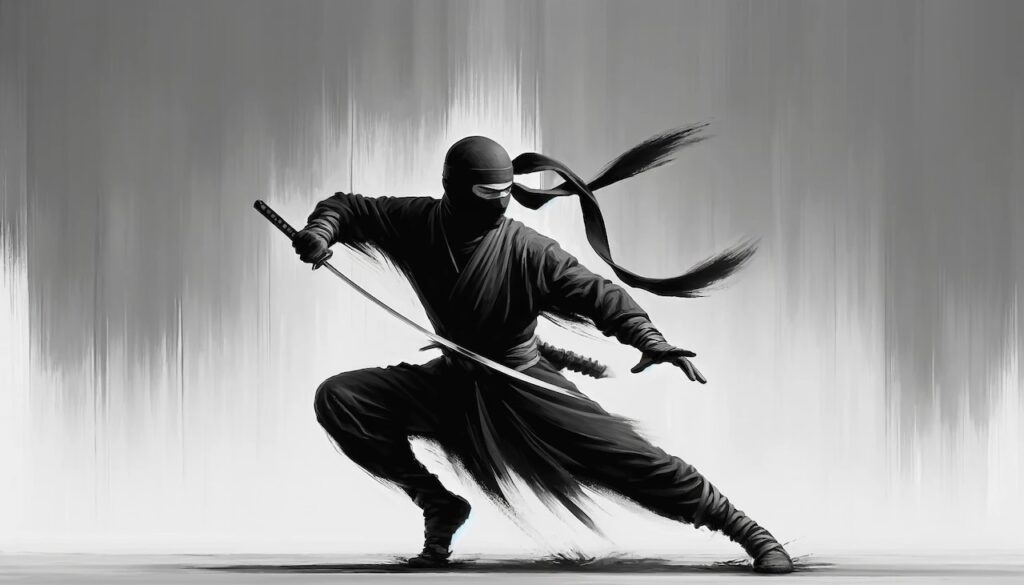Shrouded in secrecy, dressed in black, and wielding mysterious weapons—ninja have captured imaginations around the world for centuries. But who were these elusive agents of espionage, and how did they come to occupy such an iconic place in Japanese history and culture?
Let’s explore the real origins, evolution, and legacy of ninja, separating historical fact from pop culture fiction.
Where It All Began: The Roots of Ninjutsu
The origins of ninja trace back to ancient mountain ascetics known as yamabushi and shugenja. These spiritual practitioners lived in remote regions, honing physical and mental discipline through ascetic training. Over time, their survival skills, stealth tactics, and knowledge of the terrain evolved into what would become ninjutsu—the art of stealth and strategy.
The word “ninja” first appeared in historical texts during the 14th century, notably in the war chronicle Taiheiki. Early ninja were often hired as spies and scouts, valued for their ability to gather information and infiltrate enemy strongholds.
The Sengoku Period: The Golden Age of Ninja
The Sengoku period (late 15th–16th century)—an age of civil war and constant conflict—marked the height of ninja activity. With feudal lords vying for power, covert operations became essential, and ninja were in high demand.
Two prominent ninja strongholds emerged:
- Iga Province (modern-day Mie Prefecture)
- Kōga Province (modern-day Shiga Prefecture)
These regions produced organized ninja clans renowned for their skills in:
- Espionage
- Sabotage
- Infiltration
- Assassination
Famous Ninja of the Era
- Hattori Hanzō: Perhaps the most legendary ninja of all, he served Tokugawa Ieyasu, excelling in reconnaissance, strategy, and covert diplomacy.
- Kirigakure Saizō: Said to have operated under Uesugi Kenshin, he gained fame for his infiltration missions and sabotage tactics—though some legends blur the line between fact and folklore.
Decline and Adaptation: Ninja in the Edo Period
With the unification of Japan under the Tokugawa shogunate, the Edo period (1603–1868) ushered in relative peace. As full-scale war faded, so too did the demand for ninja warriors. However, ninja did not vanish—they adapted.
They were employed as:
- Bodyguards
- Intelligence agents
- Crime investigators
- Security specialists
Notable Edo-Era Ninja
- Negoro Masubee: Served the Tokugawa regime in public security and criminal apprehension.
- Momochi Sandayū: A disciple of Masubee, he compiled the Bansenshukai, a comprehensive ninjutsu manual documenting ninja philosophy, weapons, and techniques.
Ninja Today: Legacy, Preservation, and Pop Culture
By the Meiji period, the practical role of ninja had all but disappeared. But their legacy endured—and even flourished in a new form.
Modern efforts to preserve and promote ninja culture are centered in:
- Iga City (Mie Prefecture)
- Kōka City (Shiga Prefecture)
These regions host museums, demonstrations, and interactive experiences, offering a glimpse into the world of historical ninja.
Contemporary Keepers of the Tradition
- Jin’ichi Kawakami: A descendant of the Kōga clan and a scholar of ninjutsu history, he actively preserves ancient techniques.
- Daisuke Tsukuba: Head of the Togakure school, one of the few organizations continuing traditional ninja training. He promotes ninja heritage domestically and internationally.
Behind the Mask: The Real Ninja
Forget the Hollywood myth—real ninja were not magical assassins or mystical warriors. They were strategists, spies, and survivalists.
Their skillset included:
- Disguise and infiltration
- Silent movement and camouflage
- Use of tools like shuriken, kunai, and makibishi
- Knowledge of herbs and poisons
- Psychological warfare and misdirection
Rather than brute strength, ninja relied on ingenuity, adaptability, and deep local knowledge—making them indispensable in times of war and unrest.
Conclusion: The Enduring Allure of the Ninja
The true story of the ninja is one of discipline, intelligence, and adaptability. From mountain mystics to espionage operatives, from war-torn battlefields to modern museums and manga, ninja have walked a unique path through Japanese history.
Today, they stand not just as figures of fascination, but as a testament to Japan’s complex relationship with secrecy, strategy, and survival. To learn about ninja is to peel back the layers of history—and step quietly into the shadowy corners of the past.



